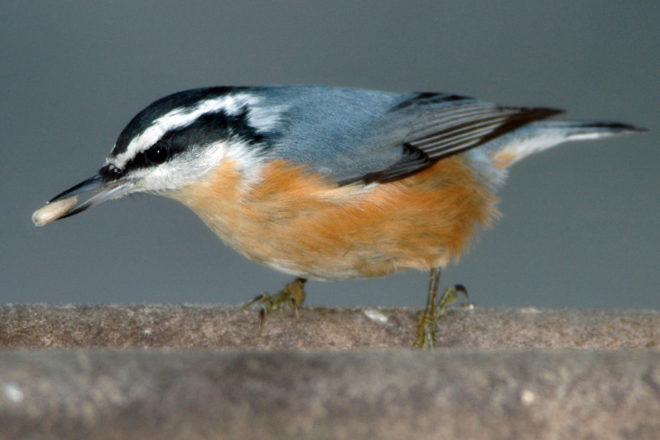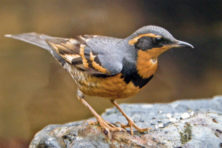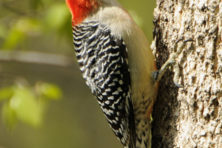Door to Nature: Winter Bird Feeding
- Share
- Tweet
- Pin
- Share

Forty years ago, when we moved into our new home in the middle of the county – within a large upland hardwood forest with only a few scattered hemlock trees – the habitat was quite different from the Lake Michigan conifer woodland where we had lived previously. Our home was 180 feet higher in elevation and was in a place that had less cover of conifers and shrubs.
We set up bird feeders in the front yard, and after the feeders were set and filled, hardly any birds visited them. A former neighbor jokingly told us to put up a big sign at The Ridges’ Upper Range Light – where we had lived previously – pointing to where we had moved so that the birds would know where to find us.
Eventually, the resident woodpeckers, chickadees and white-breasted nuthatches discovered this new source of food. We collected unsold conifers from Christmas tree lots and made a wind break on the west side of the feeders to create shelter for the smaller birds. Now there are some white cedars planted to provide the same protection from cold winds and snow.
It took several years before any cardinals found our food, and there were many years when they never appeared. When we lived at The Ridges, we had had as many as 20 cardinals at the feeder at one time. The trees surrounding them were thick conifers, which offered great hiding places.
One bird that my late husband, Roy, really missed was the red-breasted nuthatch – a small singer that he called the “northwoods oboist.” They are very common in the cedar woods along the lakeshore but quite rare in the upland hardwoods.
A year after we bought the land, we planted 500 bare-root spruce trees to produce a wind break and barrier from the strong, northwest winds that scoured the open fields to the west. It took about 20 years, but finally we were seeing an occasional red-breasted nuthatch at the feeders. One year they actually nested and were here all year.
When we lived at The Ridges, the only woodpeckers visiting the suet feeders were the downy and hairy varieties; rarely did we see a pileated. Now I have five or six pileateds coming to eat the marvel meal and suet.
I place a handful of shelled peanut halves on the lower level of the large platform feeder for the chickadees and nuthatches. They know exactly where to find these treasured treats, and even a few downy woodpeckers find them as well. However, one female pileated comes to eat marvel meal and then spies the peanuts. This morning I saw her fly to the platform and snatch peanut after peanut from the lower shelf. I had to go out and chase her away.
Bird food is becoming more expensive, as is all of our food, but one type that is not as costly as sunflower seeds is millet seed. I buy a bag and scatter some on the ground along with cracked corn. The juncos and American tree sparrows love to eat both. I also put a small pile of millet on the more protected, covered east platform, where the juncos can eat in safety.
There were few red-bellied woodpeckers here back in the 1970s. It wasn’t until August of 1983 that we saw one at our feeders. Now these rather dominant woodpeckers are here all year and are displaced from the suet or marvel meal only by the pileateds. All other resident winter woodpeckers give way when a red-bellied lands on the suet.
I have a small water bath that is heated with a round unit to keep it free of ice during the day. Roy dug a trench from the house to the pedestal on which the bath sits, and then he ran a heavy wire in the trench out to the leg of the stand and affixed a plug. This way, I can leave the heater in the bath, unplug it inside the house at night and then just plug it in again in the morning. Birds really appreciate having fresh water to drink.
Mourning doves make a regular visit each day. They eat the black oil sunflower seeds on the big platform, but they also enjoy the cracked corn on the ground. Unfortunately, they are easy targets for the accipiters that spend the winter in the area. I’ve had Cooper’s hawks and female sharp-shinned hawks take birds in my yard because the doves are slow fliers.
The other feeder that attracts small birds such as goldfinches, chickadees and nuthatches is a cylindrical container with hulled sunflower seeds, and its four perches are always occupied.
With cold weather here during this time of year, we need to keep the feeders cleaned and filled regularly. Also clean your heated bird baths, and put out fresh water each day. The birds will truly appreciate that.



